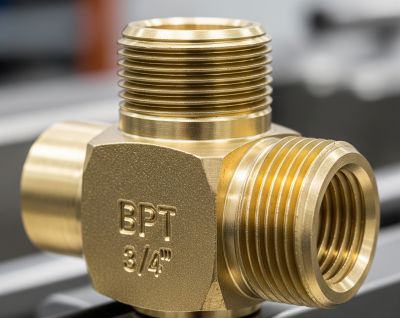When it comes to piping and fluid systems, the integrity of connections plays a vital role in ensuring safety, efficiency, and leak-free operation. One of the key elements in these systems is the type of pipe thread used. Pipe threads are designed to create a tight seal between pipes and fittings, preventing leaks and maintaining pressure. Among various thread standards worldwide, the BPT connection, or British Pipe Taper thread, is widely used in many industrial and commercial applications.
In this guide, we’ll explore what a BPT connection is, how it works, and why it’s important. Whether you’re an engineer, plumber, or simply curious about pipe fittings, this overview will help you understand the basics of British Pipe Taper threads and how to properly use them.
What Does BPT Stand For?
BPT stands for British Pipe Taper. It refers to a specific type of tapered thread standard used primarily in the UK and other countries that follow British engineering standards.
The BPT connection is standardized under BS EN 10226-1, which is also commonly referred to as BSPT (British Standard Pipe Taper). This standard defines the thread angle, pitch, and taper dimensions to ensure consistency and compatibility across fittings and pipes.
Key Features of BPT Threads:
➡️ Taper angle: The thread is tapered at a 1:16 ratio, meaning the diameter decreases slightly along the length of the thread to create a tight, pressure-resistant seal.
➡️ Thread form: The thread profile has a 55-degree angle, which is different from the 60-degree angle used in some other thread standards like NPT.
➡️ Sealing method: The seal is formed by the metal-to-metal interference created by the taper, often assisted by sealants such as PTFE tape or thread compounds.
How Does a BPT Connection Work?
The design of a BPT connection revolves around its tapered threads. Unlike parallel threads that rely solely on additional sealing materials, the taper causes the threads to wedge tightly together as the fitting is screwed in, creating a mechanical seal.
Sealing Mechanisms:
➡️ Thread interference seal: The taper causes the threads to compress against each other, generating a seal that can handle moderate pressure without leakage.
➡️ Use of sealants: Although the tapered threads create a tight seal, sealants like PTFE tape or pipe dope are often applied to enhance sealing, lubricate threads, and prevent galling (thread damage).
Advantages of Tapered Threads:
➡️ Better handling of pressure due to the wedging action of the threads.
➡️ Reduced risk of leaks compared to parallel threaded connections without additional seals.
➡️ Durable and reusable connections when installed properly.
BPT vs Other Common Thread Types
Understanding how BPT compares with other thread types is essential for selecting the right connection.
BPT vs NPT (National Pipe Taper)
➡️ Thread angle: BPT has a 55-degree thread angle; NPT uses a 60-degree angle.
➡️ Standard: BPT is a British standard (BS EN 10226-1), while NPT is an American standard (ANSI/ASME B1.20.1).
➡️ Compatibility: These threads are not interchangeable due to differences in angle, pitch, and taper, which can cause leaks if mismatched.
BPT vs BSPP (British Standard Parallel Pipe)
➡️ BPT threads are tapered, BSPP threads are parallel (straight).
➡️ BSPP connections usually require an additional sealing method, such as an O-ring or gasket, because the threads themselves do not create a seal.
➡️ BPT is often preferred in applications requiring pressure-tight metal-to-metal sealing.
When to Use BPT Over Other Thread Types
Choose BPT threads when you need a tapered, pressure-tight connection that conforms to British standards—common in plumbing, hydraulics, and gas systems in countries following British engineering protocols.
Common Applications of BPT Connections
BPT connections are widely used across various industries due to their reliability and standardization.
Industries Using BPT Connections:
➡️ Plumbing: For water supply and drainage pipes, especially in UK-based systems.
➡️ Hydraulics: Fluid power systems frequently use BPT fittings for high-pressure lines.
➡️ Gas lines: Secure, pressure-tight connections are vital in gas delivery systems.
Equipment and Systems:
➡️ Pumps, valves, and compressors
➡️ Hydraulic cylinders and actuators
➡️ Gas regulators and pipelines
Benefits:
➡️ Compatibility with widely adopted British standards.
➡️ Strong, leak-resistant connections under pressure.
➡️ Ease of installation and maintenance.
How to Identify a BPT Thread
Proper identification is crucial to ensure compatibility and avoid costly leaks or failures.
Visual and Measurement Tips:
➡️ Look for tapered threads: the diameter narrows along the length.
➡️ Use a thread pitch gauge to check the pitch (typically 14 threads per inch for common BPT sizes).
➡️ Check the thread angle (55 degrees for BPT).
Tools Used:
➡️ Thread pitch gauges
➡️ Calipers for measuring diameter and taper
➡️ Thread profile comparators or gauges
Identifying the thread type accurately helps avoid mixing incompatible fittings and ensures a proper seal.
Installation Tips for BPT Connections
Proper installation is key to maximizing the performance of BPT connections.
Best Practices:
➡️ Always clean threads before installation.
➡️ Use the correct sealant such as PTFE tape or pipe dope applied evenly in the direction of the thread.
➡️ Tighten fittings according to manufacturer specifications; overtightening can damage threads or cause leaks.
Common Mistakes to Avoid:
➡️ Mixing BPT threads with incompatible thread types (e.g., NPT).
➡️ Using insufficient or excessive sealant.
➡️ Not tightening fittings adequately, leading to loose connections.
Conclusion
Understanding what a BPT connection is and how it functions is essential for anyone working with piping systems, especially in regions that use British standards. The tapered design, reliable sealing method, and widespread application make BPT threads a cornerstone in plumbing, hydraulics, and gas systems.
When selecting pipe threads for your project, consider the standards, compatibility, and installation requirements of BPT connections to ensure a secure and leak-free system.
For more information, explore other pipe thread types and fitting standards to make well-informed decisions for your specific needs.
Post time: Aug-08-2025


